Research from the Kaiser Family Foundation found that children between the ages of 8 to 18 spend up to eight hours online each day.
June is National Internet Safety Month. As schools close for summer recess, young students will have even more free time to roam the web. Here are threats to children and teens on the internet and advice on how to eliminate these threats from your home.
There has been a significant increase in heavy internet use among youth in recent years. While 24% of teens reported they used the internet “almost constantly” in 2014, this figure nearly doubled to 45% in 2018. A total of 95% of teens have access to smartphones in 2018 compared to 73% in 2015.
Potential risks of too much screen time include:
- Poor sleep habits
- Changes in behavior
- Effect on brain development
- Sedentary lifestyle
Cyberbullying is when someone bullies others on the internet and/or electronically. This can involve text, email, gaming platforms, social media and smartphones.
Some of the risks of cyberbullying include:
- Ability to reach masses in seconds
- Eliminates “safe zones” like the home
- Offer anonymity to perpetrator
- Difficult to police and punish
3. Privacy and Identity Theft
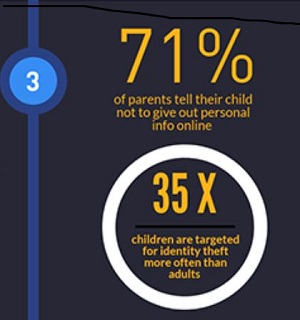 When online, children can unknowingly reveal enough personal details such as address and phone number to enable their identity to be stolen. Many sites ask children questions about themselves, including pictures with friends, their names, favorite music, and where they live. Because many young children may not need their Social Security Number for employment until they are older, which means if a child’s identity is stolen it may go unnoticed for years.
When online, children can unknowingly reveal enough personal details such as address and phone number to enable their identity to be stolen. Many sites ask children questions about themselves, including pictures with friends, their names, favorite music, and where they live. Because many young children may not need their Social Security Number for employment until they are older, which means if a child’s identity is stolen it may go unnoticed for years.
Ways to protect your child from identity theft:
- Check their social media privacy settings
- Check their device settings for location services, Bluetooth sharing, etc.
- Check your child’s credit report for any suspicious activity. It’s free to do so at https://www.annualcreditreport.com/index.action
- Block pop-ups
4. Online Grooming
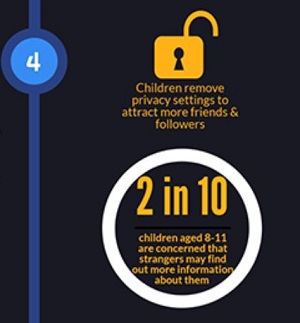 As children become more relaxed and accustomed to talking to strangers online, it’s important to think about the implications. Grooming refers to people befriending children in order to take advantage of them for sexual purposes, often by pretending to be another child. One area this is found is with online video games, where the perpetrator exploits the fun and entertaining environment.
As children become more relaxed and accustomed to talking to strangers online, it’s important to think about the implications. Grooming refers to people befriending children in order to take advantage of them for sexual purposes, often by pretending to be another child. One area this is found is with online video games, where the perpetrator exploits the fun and entertaining environment.
Signs your child may be groomed
- A desire to spend more and more time online
- Being secretive about who they are talking to and what sites they visit
- Switching screens when you come near the computer
- Using sexual language you wouldn’t expect them to know
5. Online Reputation
A ke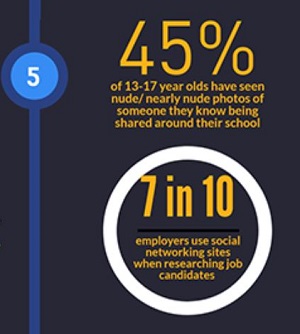 y danger of internet use for children is that everything they post is essentially a digital record for years to come. With younger children having access to smartphones and social media accounts, the risk of them having problematic content by the age of 18 continues to grow.
y danger of internet use for children is that everything they post is essentially a digital record for years to come. With younger children having access to smartphones and social media accounts, the risk of them having problematic content by the age of 18 continues to grow.
Here’s how to encourage children to create a positive online footprint:
- Stress to them that nothing they post online is private
- Remind them they should not post anything they would not want their parents to see
- Convince them to build a positive online presence
6. Inappropriate Content
As children become more independent on the internet, the possibility of coming across damaging, explicit content increases. Damaging content includes pornography, violent videos, violent games, and online gambling games.
 In order to ensure young children are not exposed to inappropriate content:
In order to ensure young children are not exposed to inappropriate content:
- Set parental controls on broadband and on smart phones
- Stay on top of emerging trends and how predators are trying to entice children
- Be sure to talk with your children about your concerns

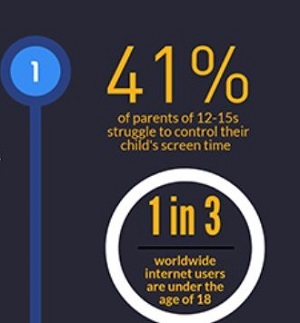
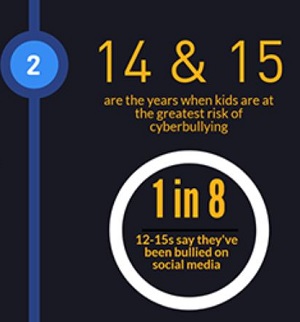
No comments yet.